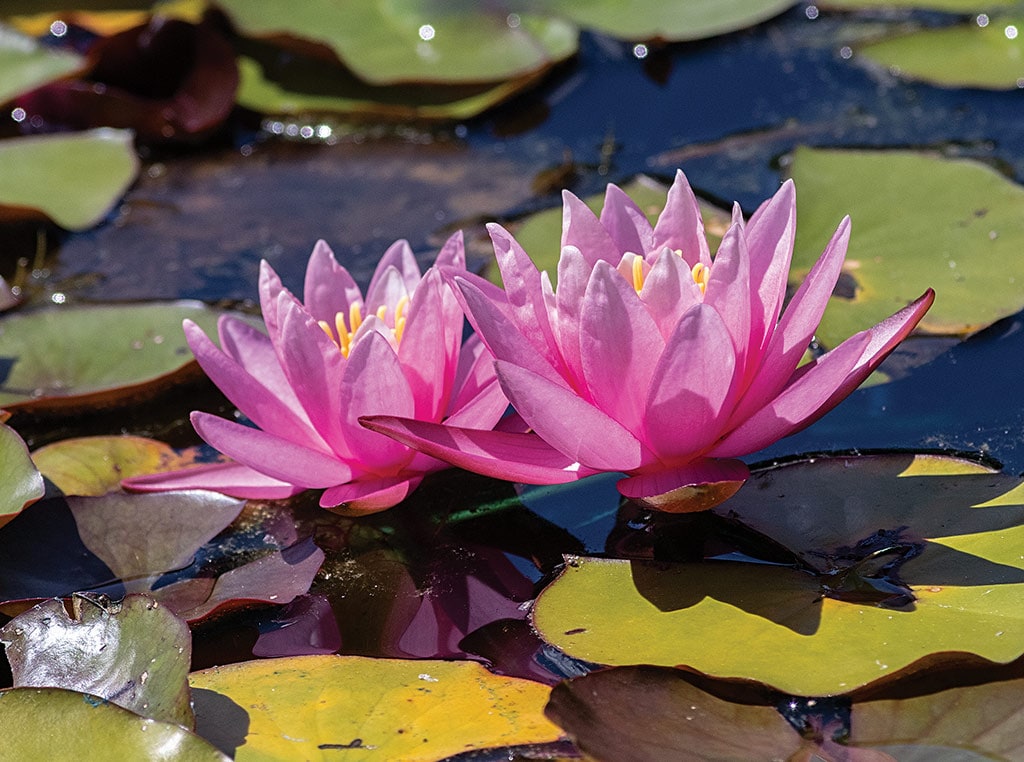Rural Living April 01, 2023
Frog Gardens
.
Living with a few ribbits pays enormous dividends.
Early April and the frog chorus fills the air announcing that spring is here. They're rarely wrong; they've been genetically programmed to be sensitive to the slight rise in temperatures. The race is on to mate and create a new generation in the host of ephemeral ponds and small creeks formed by melting snow or rainwater before they disappear.
The ageless mating dance is on and as more males join in, the song gets louder. No wonder; it's the male with the best ribbit, peep or garrrump that gets the female's attention who has the best chance of reproducing.
The chorus of frogs wafting in the evening air is one of the true joys of life beyond the city lights. But around the world amphibian numbers are dropping. Some species could quite easily disappear due to habitat loss. Fortunately, many remember the thrill of discovering frogs in their youth and the amazing sight of tadpoles changing from something that looks like a fish into a frog. They want to ensure there's a place for frogs in their garden, too. They're making their yards a link in a chain of green that acts as a stepping stone to create corridors for wildlife through our cities.

Above. Many gardeners find it a creative challenge to use aquatic plants like water lilies to maintain good water quality in their garden pond instead of using algicides and UV filtration system. Aquatic plants not only provide shade for life in the pond; they use up nutrients in the water that would otherwise just feed an algae bloom.
"Regardless of whether you live in the middle of a city or have an acreage at the edge of town, there are things that we can all do that can really make a difference in terms of sort of supporting nature better," says Barb McKean, head of education at the Royal Botanical Gardens in Burlington, Ontario. "Making our yards more ecologically functional instead of just filling them with pretty stuff is a big part of it."
Attracting frogs, toads and other amphibians pays dividends for those who want to enjoy evenings in their backyards, too. They're voracious opportunistic predators; each adult will eat tons of the mosquitoes, flies and other invertebrates that can make your outdoor lifestyle miserable.
Toads are the low hanging fruit for people who want to attract amphibians to their gardens. They need water to breed but after that they're more terrestrial than frogs are. So as long as you give them a place that stays a little moist, they'll survive.
"I've got a few broken clay pots that are hidden away, partly buried under foliage in my garden," McKean says. "You often see clay huts called toad abodes in garden centers. The toads that are found in our area (southwestern Ontario) couldn't survive in arid dry areas with no moisture around, but their needs are very minimal compared to frogs."
Toads' skin is much drier and less smooth than frogs' skin and often is described as bumpier. There's no truth to the old wives' tale that handling one causes warts. However, they do have glands around their eyes that will release an acrid liquid if you try to catch one. It gives predators like skunks and raccoons a bad taste in their mouth.
"Having access to water is obviously the most important feature you need if you want frogs to be attracted to your property," McKean says. "Some species like leopard frogs need water all the time and never go too far from it; others, like wood frogs, only need there to be water around long enough in the spring for tadpoles (their young) to mature. The rest of the time the humidity of the forest floor provides enough moisture to survive."
Above. A healthy frog garden creates an oasis for frogs, toads, and other amphibians as well as a spot for turtles and other wildlife.
Fit for a frog. Garden ponds or water features can be ideal places for them, but not all are fit for frogs. Young frogs and toads prefer to live in still, quiet water, so ponds that use big pumps for waterfalls, fountains, or run a filtration system are problematic. Small frogs and tadpoles will be killed if they are sucked into the pump's impeller. It takes a true balancing act to maintain a functional pond but for many homeowners it's this challenge that makes it interesting.
"You're really trying to create a balanced natural habitat," McKean says. "Concrete ornamental ponds that are regularly treated with algicide aren't very frog friendly. Frogs breathe through their skin; they're very sensitive to chemicals in the water. Instead of adding an ultraviolet filter that sterilizes the water and kills species that are part of frogs' and tadpoles' food chain, try balancing the plants in the pond. Add more water lilies to shade the surface; more cattails and other aquatic plants will use up the nutrients in the water that would otherwise be feeding all kinds of algae."
Give a little thought to how a small frog is going to be able to exit the pond. Frogs aren't mountain goats. Ponds surrounded by armourstone cliffs might be impossible for small frogs to get out of. McKean says that at least part of it should have a soft shoreline or a frog log at one edge that they can use to get out of the water. You can also buy floating ramps for your backyard swimming pool that give any frogs (and other small creatures) that fall into the water a way to get out of the pool before the chlorine damages their skin.
"Frogs don't just live in a pond, they need to use the area around it," McKean says. "You're really trying to create an entire frog-friendly ecosystem. Ideally you would have a diverse garden with lots of native plants. It should have lots of leafy plants, whether it's ferns or hostas, whatever will create shade to keep the sun from beating down on the soil. The goal is to create a microclimate that's cooler and moister than the surrounding area and they'll gravitate towards it."
If your property is located near a waterway, a wetland, or a large green space, odds are that if you create a frog-friendly environment, it will be naturally populated by the frogs. It also gives new generations of frogs somewhere they can move to if your yard becomes overpopulated.
But if your property is an island of green surrounded by concrete and the closest greenspace is on the far side of a giant parking lot or a major highway, that's going to be hard to overcome no matter where you are. For amphibians, it might as well be a wall, they can't cross it and they won't cross it. It just doesn't work for them.
"That's why rethinking our gardens and creating linkages between green spaces is so important," McKean says. "Leaving an unmown strip along an edge of your property creates an ecological corridor that allows amphibians and other wildlife to move back and forth between it and other islands of green.
"This small step creates much more genetically diverse and healthy populations in both spaces," McKean says. "But if we all make small changes like this in how we garden, the collective impact makes a big difference." ‡
Above. Obviously having access to water is the most important thing, Barb McKean says. Some species constantly need to be close to water while others only need it when it's time to breed. Green frogs are one of the easiest ones to find in Ontario. Like all frogs, it's an opportunistic, voracious predator. They'll wait motionless then shoot out their long tongues to catch any flies or other insects passing by.
Read More

SPECIALTY/NICHE
Adding a Chapter
Chef Travis Milton brings the Appalachian foodways of his youth into the spotlight.

RURAL LIVING, SPECIALTY/NICHE
Rolling With It
Family cinnamon roll recipe creates memories for four generations.


